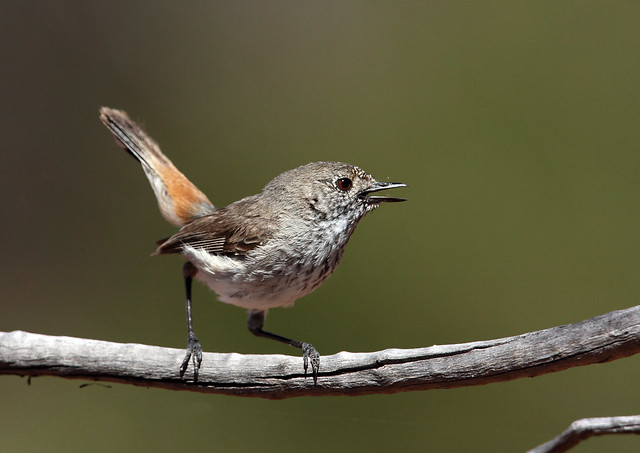Acanthiza apicalis
Superregnum: Eukaryota
Regnum: Animalia
Subregnum: Eumetazoa
Cladus: Bilateria
Cladus: Nephrozoa
Superphylum: Deuterostomia
Phylum: Chordata
Subphylum: Vertebrata
Infraphylum: Gnathostomata
Megaclassis: Osteichthyes
Superclassis: Sarcopterygii
Superclassis: Tetrapoda
Cladus: Reptiliomorpha
Cladus: Amniota
Classis: Reptilia
Cladus: Eureptilia
Cladus: Romeriida
Subclassis: Diapsida
Cladus: Sauria
Infraclassis: Archosauromorpha
Cladus: Crurotarsi
Divisio: Archosauria
Cladus: Avemetatarsalia
Cladus: Ornithodira
Subtaxon: Dinosauromorpha
Cladus: Dinosauriformes
Cladus: Dracohors
Cladus: Dinosauria
Ordo: Saurischia
Cladus: Eusaurischia
Cladus: Theropoda
Cladus: Neotheropoda
Cladus: Averostra
Cladus: Tetanurae
Cladus: Avetheropoda
Cladus: Coelurosauria
Cladus: Tyrannoraptora
Cladus: Maniraptoromorpha
Cladus: Maniraptoriformes
Cladus: Maniraptora
Cladus: Pennaraptora
Cladus: Paraves
Cladus: Eumaniraptora
Cladus: Avialae
Infraclassis: Aves
Cladus: Euavialae
Cladus: Avebrevicauda
Cladus: Pygostylia
Cladus: Ornithothoraces
Cladus: Euornithes
Cladus: Ornithuromorpha
Cladus: Ornithurae
Cladus: Carinatae
Parvclassis: Neornithes
Cohors: Neognathae
Cladus: Neoaves
Cladus: Telluraves
Cladus: Australaves
Ordo: Passeriformes
Subordo: Passeri
Parvordo: Corvida
Superfamilia: Meliphagoidea
Familia: Acanthizidae
Genus: Acanthiza
Species: Acanthiza apicalis
Subspecies: A. a. albiventris – A. a. apicalis – A. a. cinerascens – A. a. leeuwinensis – A. a. tannami – A. a. whitlocki
Name
Acanthiza apicalis Gould, 1847
Vernacular names
English: Inland Thornbill
español: Acantiza apical
فارسی: نوکخاری دمپهن
français: Acanthize troglodyte
Nederlands: Roodstuitdoornsnavel
русский: Широкохвостая шипоклювка
svenska: Inlandstaggnäbb
The Inland Thornbill (Acanthiza apicalis), commonly called the Broad-tailed Thornbill, is a small, insect-eating bird of Australia. The Inland Thornbill is commonly confused with the coastal Brown Thornbill (Acanthiza pusilla) due to its similar colorations.[2] The Inland Thornbill encompasses four subspecies [3]:
* A. a. apicalis
* A. a. albiventris
* A. a. cinerascens
* A. a. whitlocki
The thornbill ranges in size from 9 to 11 centimeters, averaging 10 centimeters and 7 grams.[4] The bird has a grey-brown back, a reddish rump, and a dark tail with a white tip. Its underbelly is cream colored with black streaks. Both male and female thornbills look similar, though male birds tend to be a bit larger.[4]
Breeding season lasts from July through December. Female thornbills average three eggs per clutch, which incubate for 19 days. Baby birds leave the nest after 17 days.[4]
The thornbill can be found throughout Australia inland of the Great Dividing Range, but not in tropical northern climates or in Tasmania.[2] The Inland Thornbill overlaps in range with the Brown Thornbill along the Great Diving Range, leading to numerous mis-sightings.[4] Inland thornbills live in dry scrublands and woodlands. In Southwestern Australia, they also inhabit sand heaths and karri and jarrah forests.[4] It feeds on small insects and spiders, and occasionally seeds and small vegetable matter, beneath shrubs and in foliage.
References
1. ^ BirdLife International (2008). Acanthiza apicalis. In: IUCN 2008. IUCN Red List of Threatened Species. Downloaded on 18 February 2009.
2. ^ a b Oz Birds: Inland Thornbill. 2006. Accessible via
3. ^ Taxonomy Question
4. ^ a b c d e Birds in Backyards: Inland Thornbill Factsheet. Australian Museum. 2006. Accessible via: [1]
Retrieved from "http://en.wikipedia.org/"
All text is available under the terms of the GNU Free Documentation License


